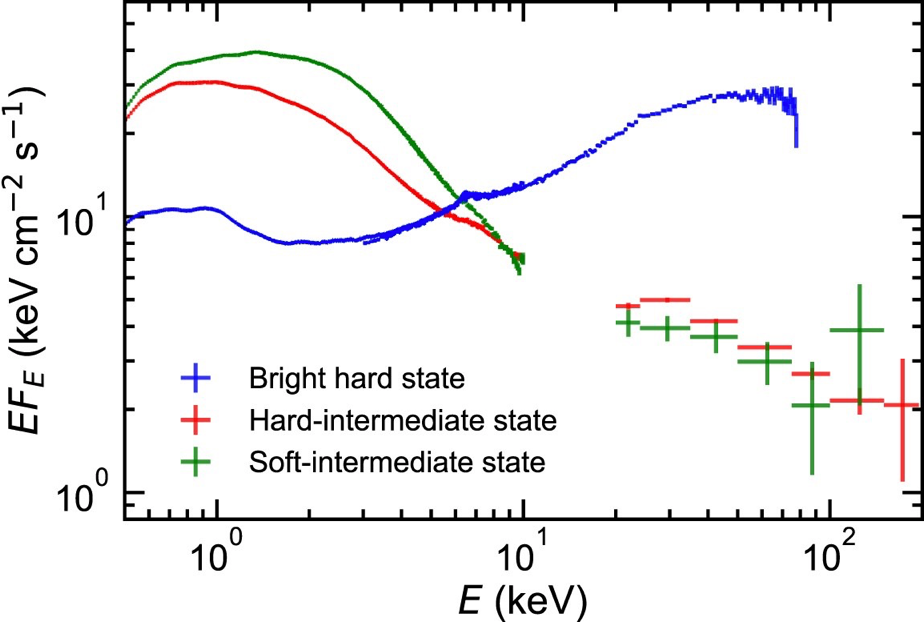NICER / ISS Science Nugget
for September 7, 2023
Do lags propagate or reverberate?
Black-hole binaries that erupt in weeks-long outbursts undergo a consistent sequence of transitions characterized primarily by their spectral properties -- i.e., by the distribution of X-ray photon energies we receive. At the earliest times, high-energy X-rays dominate, in the so-called "bright hard" state; the origin of this emission is a million-degree ionized gas in the near vicinity of the black hole. Later, lower-energy X-ray emission brightens and takes over as the dominant component; this is the "intermediate" state, which can be subdivided into the hard- and soft-intermediate states (HIMS and SIMS). The lower-energy photons emerge from the matter flowing from the companion star through an accretion disk that gradually fills in and heats up as it approaches the black hole. Finally, and abruptly, a "soft state" is seen, in which the high-energy component essentially disappears and the soft emission from the disk remains.
Because these accretion flow structures are much smaller than the spatial resolving capabilities of any of our telescopes, their geometries and spatial relationships are uncertain, but timing of their brightness fluctuations offers a uniquely capable probe. Correlations between high-energy and low-energy brightness are measurable on slow as well as fast timescales. In the different accretion states, these correlations are seen to switch signs: sometimes, the high-energy fluctuations lag behind the low energies (so-called "hard lags"), and at other times the high energies precede the soft ("soft lags"). A recent paper, by T. Kawamura (Univ. of Tokyo) & collaborators published in the peer-reviewed U.K. journal Monthly Notices of the Royal Astronomical Society, explores these time lags and the varying overall spectra during the 2018 outburst of the black-hole binary MAXI J1820+070, which was extensively tracked by NICER. Specifically, the authors focus on the transition between the bright-hard state and the intermediate states. Their results, and their emerging spatial model, challenge the notion that the longest soft lags seen from this system are due to "reverberation" -- i.e., the light-travel-time echoes of high-energy photons being reprocessed in the accretion disk. Instead, they propose that low-energy photons from the disk "seed" the hot plasma just beyond the disk's inner edge, with turbulence at this edge leading to soft fluctuations in a radially stratified plasma region.
Continuing NICER observations of transient black-hole outbursts across accretion states will continue to test this and other models of accretion flow geometries.


Left: Spectra of the black-hole binary MAXI J1820+070 obtained during parts of its 2018 outburst by NICER and NASA's NuSTAR telescope (blue points, in the bright-hard accretion state), and later by NICER and the Burst Alert Telescope instrument on-board NASA's Swift observatory (red and green points, in two intermediate accretion states). The inversion of the dominant photon energies from high (in the hard state) to low (in the intermediate states) is evident. Also, spectral differences between the two intermediate states are restricted to energies below 10 keV. (Credit: Kawamura et al. 2023)
Right: Proposed model for the transition from the bright-hard to the hard-intermediate states, motivated by NICER measurements of time lags between brightness fluctuations in low- and high-energy photons. R_g refers to the "gravitational radius," approximately 1.5 km for a black-hole with a mass equal to that of our Sun. The "Compton" regions are occupied by ultra-hot plasmas that, through scattering interactions, boost low-energy seed photons from the accretion disk -- seen edge-on at left -- to much higher energies. (Credit: Kawamura et al. 2023)
<< Previous
Main Index
Next >>